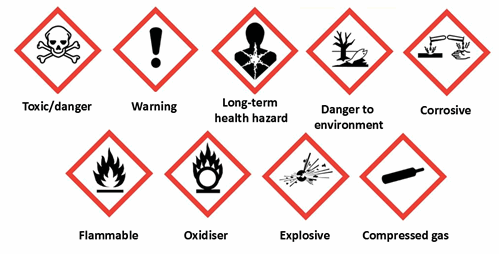 Most businesses use substances, or products that are mixtures of substances. Some processes create substances. These could cause harm to employees, contractors and other people. Sometimes substances are easily recognised as harmful. Common substances such as paint bleach or dust from natural materials may also be harmful.
Most businesses use substances, or products that are mixtures of substances. Some processes create substances. These could cause harm to employees, contractors and other people. Sometimes substances are easily recognised as harmful. Common substances such as paint bleach or dust from natural materials may also be harmful.
The COSHH Regulations apply to any substances that are hazardous to health.
Substances can take many forms and include:
• chemicals
• products containing chemicals
• fumes
• dusts
• vapours
• mists
• nanotechnology
• gases and asphyxiating gases and Biological agents (germs).
If the packaging has any of the hazard symbols, then it is classed as a hazardous substance
You’ll find specific symbols on the labels of any chemicals that can be hazardous to someone’s health. All symbols are contained within the shape of a diamond, with a bold red border. There are nine symbols to look out for:
- Explosive
- Flammable
- Oxidising
- Corrosive
- Acute toxicity
- Hazardous to the environment
- Health hazard/Hazardous to the ozone layer
- Serious health hazard
- Gas under pressure
In some cases, more than one symbol might appear on a single label. Some substances are easier to identify as harmful than others. However, just because something’s harder to recognise, it doesn’t mean it can go ignored. When dealing with COSHH, care should always be taken to ensure all hazards and risks are either prevented, reduced or controlled as much as possible.
Your legal responsibilities as an employer
You’re required to follow several steps to prevent or reduce any potential risks. These are:
- Identify what could cause health hazards
- Conduct a thorough, COSHH risk assessment to prevent any risks from materialising
- Implement control measures to prevent or reduce any risks discovered in your assessment
- Regularly monitor that everybody is following your control measures
- Make sure your control measures remain in good working order
- Supply affected individuals with sufficient information, instruction and training on how to safely work with hazardous substances
- Where appropriate, conduct health surveillance surveys
- Put together a plan for in the event of an emergency
